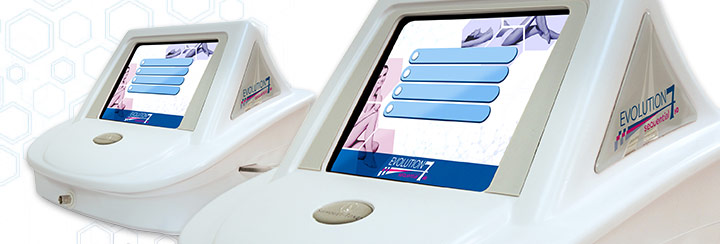News & Events
Electrology and the Hirsute Polycystic Ovary Syndrome Patient
by: Ricardo Azziz, M.D., M.P.H., M.B.A., Professor Departments of Obstetrics and Gynecology, and Medicine, The University of Alabama at Birmingham, Birmingham, Alabama and Teresa Petricca, CPE, Executive Director, American Electrology Association
Most Hirsuit Patients Have PCOS
Hirsutism is generally a sign of underlying androgen excess, i.e. hyperandrogenism. As such non-androgenic causes of hirsutism (i.e. not related to excessive androgen action) are relatively rare, accounting for less than 1% of affected patients in our experience. A more common cause of hirsutism, the so-called idiopathic hirsutism (IH) is established by exclusion in a patient who is obviously hirsute, but in whom the circulating androgens and ovulatory function appear to be normal (2). However, it should be noted that about 40% of hirsute women who claim to be regularly menstruating actually do not ovulate well (are oligo-anovulatory), and hence probably suffer from PCOS and not IH (3). Overall, between 5% and 15% of hirsute women will have the diagnosis of IH (2). However, it should be understood that many of these patients simply demonstrate degrees of hyperandrogenemia that may not be detectable with routine clinical androgen assays and, in fact, this diagnosis may be more indicative of "inaccurate" hormonal assay. Nonetheless, in some of these women the 5?_-reductase activity in the skin and hair follicle is probably independently overactive, leading to hirsutism in face of "normal" circulating androgen levels.
Androgenic causes are by far the most common cause of hirsutism, accounting for approximately 75% to 85% of such patients. Androgen disorders include PCOS, which affects about 70-80% of hirsute women, the hyperandrogenic-insulin resistant-acanthosis nigricans (HAIRAN) syndrome affecting about 3%, 21-hydroxylase deficient non-classic adrenal hyperplasia (NCAH) in 2-8% of patients, and very rarely, ovarian or adrenal androgen-secreting neoplasms (ASN) (4). The most common diagnosis in the hirsute patient, PCOS, is actually a diagnosis of exclusion such that this disorder is diagnosed in those patients with evidence of ovulatory dysfunction in the face of either biochemical or clinical evidence of hyperandrogenism, and after the exclusion of related disorders (i.e. NCAH, HAIRAN syndrome, ASNs, thyroid and prolactin dysfunction).
Hormonal Treatment of Hirsutism in PCOS
Hirsutism is not only cosmetically disfiguring, but also can be a significant handicap to a young woman's social life and emotional happiness, detrimentally affecting the quality of life of affected women. Hence, treatment should be undertaken as soon as the diagnosis is established, to minimize the number of terminalized hair follicles. Furthermore, since hirsutism is principally a sign of an underlying endocrine or metabolic disorder, these patients should undergo a thorough evaluation as soon as possible. Overall, because most hirsute patients suffer from PCOS, these patients are at greater risk for developing infertility, irregular menstrual bleeding, endometrial carcinoma, type 2 diabetes mellitus, and possibly cardiovascular disease.
Hormonal therapy of hirsutism consists of medications that either suppress androgen production or free androgen levels, or block androgen action. Ovarian androgen suppression can be accomplished with combination oral contraceptives, long acting GnRH analogs, ketoconazole, or insulin sensitizing drugs. However, the transient suppression of ovarian androgens achieved using surgery, such as laparoscopic ovarian drilling, has little effect on hair growth. Furthermore, adrenal androgen suppression using glucocorticoids also has a limited effect, if any, on hirsutism. Nonetheless, the impact of androgen suppression alone on unwanted hair growth is relatively modest.
Most women with clinically significant hirsutism will require the addition of medications to block androgen action. These include androgen receptor blockers such as spironolactone, flutamide, and cyproterone acetate (which is also a progestin that suppresses ovarian androgen secretion). In turn, finasteride will decrease androgen-dependent hair growth by inhibiting 5_-reductase, and the peripheral conversion of T to DHT. Overall, all drugs that block androgen action provide similar results, such that side effects will the most important feature in determining patient preference (5,6). In general, the main purposes of hormonal therapy in the treatment of the hirsute woman is to correct the underlying problem, to stop new hairs from growing, and to potentially slow the growth of terminal hairs already present. Although hormonal therapy alone will sometimes produce a thinning and a loss of pigmentation of terminal hairs, it generally will not reverse the terminalization of hairs.
Hence, women who suffer from hirsutism require the removal by mechanical means of any remaining unwanted terminalized hairs.
Mechanical Means of Treating Hirsutism
Many hirsute patients resort to shaving, bleaching or depilating, which are acceptable methods of controlling the appearance of the unwanted hairs with a minimum of side effects. However, the use of plucking and/or waxing in androgenized skin areas should be discouraged since these techniques not only do not kill the hair follicles, but also have the significant potential of inducing folliculitis and damage of the hair shaft with subsequent development of ingrown hairs and further facial damage. Techniques to accomplish the destruction of unwanted hair follicles include electrology and, potentially, laser hair removal.
Laser hair removal has been proposed as treatment for the hirsute patient, however most studies have been uncontrolled and included fewer than 50 patients, none have been blinded, and all have used a variety of treatment protocols, equipment, skin types, and hair colors studied. In general, laser hair removal is most successful in patients with lighter skin color (Fitzpatrick skin colors I-IV) and who have dark colored hairs. Repeated therapies are necessary, although complete hair loss is rarely achieved and it is unclear at what point maximum benefit is achieved from multiple treatments. In general, treatment with the ruby, alexandrite, or diode lasers, or the IPL results in similar success rates, although it may be somewhat lower for the nd:YAG laser. Overall, laser hair removal should not be considered “permanent”, at least considering the current data available, consistent with the opinion of the FDA.
Electrology
Electrology, a technique useful for the destruction of unwanted hair follicles, has been in use for over a century. There are three modalities of electrology. Electrolysis refers to the application of direct or galvanic current (DC, e.g. from a battery), using one or more sterile needles/probes, to achieve the chemical destruction of the hair follicle. Thermolysis uses alternating current (AC, e.g. as in regular electricity) whose frequency is increased and delivered through a single sterile needle/probe, creating heat which destroys the hair follicle. The current used in thermolysis has also been called short wave or high frequency. Finally, the Blend or dual modality technique uses both of the above currents, applied simultaneously or sequentially generally through a single sterile needle/probe, to achieve dual action destruction of the hair follicle. All three modalities (multiple needle galvanic, thermolysis and the Blend) successfully achieve the goal of destroying those cells in the hair follicle, which are capable of producing hair.
Dr.Charles E. Michel, recognized as the father of electrolysis hair removal, was a St. Louis, Missouri opthamologist who conducted exhaustive research to find a successful technique for removing ingrown eyelashes. In 1875 he reported that he was able to destroy ingrown eyelashes by the simple process of inserting a needle, charged with negative galvanic current, into a hair follicle. This technique was refined further with the use of multiple needles by Professor Paul M. Kree of New York in 1916. Professor Kree played an important part in the growing acceptance of electrolysis as a practical means of hair removal since his multiple needle method was much faster than the single needle procedure that had been used until that time, although it was still slow by today's standards.
Almost 50 years after Dr. Michel's findings, Dr. Henry Bordier of Paris, France, reported in 1923 that hairs could be destroyed by the application of high frequency or AC current. This observation led to the development of thermolysis. Unlike multiple needle electrolysis, which was manual, the new thermolysis equipment delivered current of such high intensity that it was controlled by an automatic timer. Until the late 1930's, the only high frequency thermolysis equipment available was modified medical diathermy machines. These early machines had no calibrated dials to judge timing and intensity and were influenced greatly by humidity and temperature. Modern thermolysis equipment is highly calibrated and exact. Some epilators feature a treatment duration of as short as 1/1000th of a second.
In 1938, Henri St. Peirre of San Francisco, California, in collaboration with Arthur Hinkle began developing a machine to destroy hair follicle using a combination of the two currents previously used, AC and DC, in an effort to combine the speed of the AC and the efficiency of the galvanic (DC) method. In 1948 Mr. St. Pierre was granted a patent for a machine producing electrology by what we today know as the Blend modality.
Electrolysis in the Treatment of Hirsutism
The U.S. Food and Drug Administration (FDA) recognizes electrology as providing permanent hair removal. The FDA identification in Title 21, CFR, Sec. 878.5350 for needle-type epilators is: "a device intended to remove the hair by destroying the dermal papilla of a hair". As no other device for hair removal has the unique identification of "destroying the dermal papilla of a hair", only electrologists are allowed to claim permanent hair removal in their advertising. No other hair removal devices, including lasers, have been able to achieve this definition.
Electrolysis (i.e. electroepilation) is the only method proven to remove hair permanently, and results in long term hair destruction (7,8). The reported efficacy with repeated treatments is permanent destruction (alopecia or hair loss) in 15% to 50% of the hairs treated (9). The number of treatments necessary varies with each person. It is very important to adhere to the recommended treatment schedule to achieve optimum results in the shortest period of time. While electrolysis is a very comfortable procedure, it is impossible to destroy hair growth tissue without any sensation, because each hair follicle is surrounded by its own network of nerve endings. Even though some parts of the body are more sensitive than others, adjustments can be made which will help to make the treatment remain comfortable. Some patients may require the application of local anesthetics to the skin prior to treatment, such as EMLA Cream (an emulsion of lidocaine 2.5% and prilocaine 2.5%, Astra-Zeneca Pharmaceuticals LP).
Side effects, including scarring can occur after electrolysis, especially if inexpertly performed (10). However, we should note that scarring is rare today, and when a competent electrologist using up-to-date equipment and current techniques performs electrolysis, there should be no visible skin damage. The use of the older galvanic devices did cause scarring years ago, as the needles were made of unshielded metal, potentially resulting in skin burns. Today the needles for galvanic devices are shielded (insulated) to prevent this from happening. Overall, the safety and effectiveness of needle-type electrolysis has been substantiated through more than one century of use.
Importantly, it should be recognized that electrologists are often the first individuals to whom the hirsute patient turns for assistance. In one study of 779 consecutive new clients seeking electrology 40% were noted to have potential risk factors for hyperandrogenism according to their response to a standardized questionnaire (11). When a representative group of these at risk women were evaluated approximately 20% of women had a hirsutism score greater than six, while PCOS was evident in over 50%. Surprisingly, only 26% of the at risk clients referred for a free medical evaluation actually followed through, an indication of the degree of lack of awareness regarding the availability of medical treatment that exists among hirsute women.
Selecting an Electrologist
The importance of selecting a well-trained electrologist cannot be under-emphasized. The overall results of treatment will depend highly on the training and skill of the practitioner. Furthermore, regulation of electrology varies widely between the States, with those regulating the practice of electrology requiring that a practitioner hold a valid license. Currently, only thirty-one states and the District of Columbia have any type of licensure requirements (http://www.transgendercare.com/electrolysis/resources/l_states.htm). Of those licensed states, most are regulated by boards of barbering and cosmetology, and the remained states by boards of health or the office of the medical examiner. Thus, it is difficult to solely depend on State licensure to guarantee skilled and trained electrologists.
The American Electrology Association (AEA) is the only national organization dedicated to needle electrologists.. The AEA devotes much effort to educating its membership regarding PCOS. AEA members understand the need to develop a rapport and working relationship with endocrinologists and other medical specialists that treat PCOS to achieve the optimum and most complete care of the hirsute woman. Seeking an electrologist whom is both a member of the AEA and a Certified Professional Electrologist (CPE) is a good consumer guide to finding a practitioner who participates in their profession and keeps current in their field. The CPE designation indicates that the electrologist has successfully passed a comprehensive national testing given by the AEA, and that has continued to fulfill the necessary continuing education and/or re-testing requirements. A certificate from the AEA displays evidence of membership with a current year validation sticker. The AEA Referral Directory also lists the membership roster.
Third Party Reimbursement of Electrology
Coverage by Health Maintenance Organizations (HMOs) generally does not reimburse for electrolysis treatments. However, in some insurance contracts specific clauses may allow electrology patients/clients to seek reimbursement. It is suggested that you check your contract prior to requesting a letter from your primary care physician. The physician's letter must state that "electrolysis is medically necessary" as part of the overall treatment of the disorder that was diagnosed (e.g. PCOS, CPT code 256.4; or Androgen Excess, CPT code 256.1). You must then submit this letter to your insurance carrier.
A precedent has already been set indicating that depilatory treatments are "medical care" for insurance purposes (Abernathy v. The Prudential Insurance Company of America, No. 21178, Supreme Court of South Carolina, March 31, 1980). In this case Plaintiff brought suit against her insurer after it refused to reimburse her for the cost of depilatory treatments (i.e. electrolysis) which had been recommended by her physician. The policy included as "eligible expense" charges for "doctors' services for surgical procedures and other medical care", and contained a provision excluding "anything not ordered by a doctor or not necessary for medical care of illness". The South Carolina State Supreme Court affirmed a verdict for the plaintiff, noting that there is no requirement that "medical care ... be performed by or under the direction of licensed medical personnel". Further, the court held, since plaintiff underwent treatments pursuant to her physician's advice, such expenses were medically "necessary and were not excluded from coverage under the policy".
SUMMARY
Hirsutism is not only cosmetically disfiguring, but also can be a significant handicap to a young woman's social life and emotional happiness, detrimentally affecting the quality of life of affected women. Hirsutism is generally a sign of underlying androgen excess, generally PCOS, with its consequent morbidity. As such the hirsute woman merits a thorough evaluation, and the initiation of hormonal suppressive therapy as son as the diagnosis is established. Although hormonal therapy alone will sometimes produce a thinning and a loss of pigmentation of terminal hairs, it generally will not make the unwanted hairs disappear. Techniques to accomplish the destruction of unwanted hair follicles include electrology and, potentially, laser hair removal. Nonetheless, long-term data following laser hair removal is still lacking. Electrology results in the permanent destruction of unwanted hair follicles and has been in use for over a century. There are three modalities of electrology: electrolysis, thermolysis, and a blend of both electrolysis and thermolysis. Electrology has been in use for over a century, according to the FDA, only electrologists are allowed to claim permanent hair removal in their advertising. In addition, it should be recognized that electrologists are often the first individuals to whom the hirsute patient turns for assistance, and as such the electrologist forms an important part of the therapeutic team caring for these patients. However, the importance of selecting a well-trained and skilled electrologist cannot be under-emphasized. Since regulation of electrology varies widely between the States, relying on other methods of judging practitioner quality, such as the CPE certificate, becomes important in choosing an electrologist. While third party reimbursement for electrology is often not available, it is worthwhile exploring this payment option further, perhaps with the assistance of the patient's physician. Overall, electrology provides an effective and safe method of permanently removing unwanted hairs in the hirsute PCOS patient.
REFERENCES
- Knochenhauer ES, Key TJ, Kahsar-Miller M, Waggoner W, Boots LR, Azziz R. Prevalence of the polycystic ovary syndrome in unselected Black and White women of the Southeastern United States: A prospective study. J Clin Endocrinol Metab 83:3078-3082, 1998.
- Azziz R, Carmina E, Sawaya ME. Idiopathic hirsutism. Endocrine Reviews 21:347-362, 2000.
- Azziz R, Waggoner WT, Ochoa T, Knochenhauer ES, Boots LR. Idiopathic hirsutism: An uncommon cause of hirsutism in Alabama. Fertil Steril 70: 274-8, 1998.
- Sanchez LA, Knochenhauer ES, Gatlin R, Moran C, Azziz R. Differential diagnosis of clinically evident hyperandrogenism: Experience with over 1000 consecutive patients. The Annual Meeting of the American Society for Reproductive Medicine, Orlando, FL, October 20-25, 2001 (Abstract O-294. Fertil Steril 76:S111 (Supplement), 2001
- Venturoli S, Marescalchi O, Colombo FM, Macrelli S, Ravaioli B, Bagnoli A, Paradisi R, Flamigni C. A prospective randomized trial comparing low dose flutamide, finasteride, ketoconazole, and cyproterone acetate-estrogen regimens in the treatment of hirsutism. J Clin Endocrinol Metab 84:1304-1310, 1999.
- Moghetti P, Tosi F, Tosti A, Negri C, Misciali C, Perrone F, Caputo M, Muggeo M, Castello R. Comparison of spironolactone, flutamide, and finasteride efficacy in the treatment of hirsutism: a randomized, double blind, placebo-controlled trial. J Clin Endocrinol Metab 85:89-94, 2000.
- Peereboom Wynia JDR, Stolz E, van Joost T, Kleiman. A comparative study of the effects of electrical epilation of beard hairs in women with hirsutism by diathermy and by the blend method. Arch Dermatol Res 278:84 86, 1985.
- Richards RN, Meharg GE. Electrolysis: observations from 13 years and 140,000 hours of experience. J Am Acad Dermatol 33:662 666, 1995.
- Wagner RF. Physical methods for the management of hirsutism. Cutis 45:19 2, 1990.
- Kligman AM, Peters L. Histologic changes of human hair follicles after electrolysis: a comparison of 2 methods. Cutis 34:169 176, 1984.
- Farah L, Lazenby AJ, Boots LR, Azziz R, and the Alabama Professional Electrology Association Study Group. Prevalence of the polycystic ovary syndrome among women seeking treatment from community electrologists. J
FIND OUT WHAT TRAININGS ARE AVAILABLE IN YOUR STATE
Each State has different training requirements for practicing Electrology. Select your state from the map or the list below to find out more about the training programs available to you.
Click On Your State for Program Details and Pricing
Licensed States
- Arkansas
- California
- Connecticut
- Delaware
- District of Columbia
- Florida
- Hawaii
- Idaho
- Illinois
- Indiana
- Iowa
- Kansas
- Louisiana
- Maine
- Massachusetts
- Maryland
- Michigan
- Montana
- Nebraska
- Nevada
- New Hampshire
- New Jersey
- New Mexico
- North Carolina
- North Dakota
- Ohio
- Oklahoma
- Oregon
- Rhode Island
- Tennessee
- Utah
- Vermont
- Wisconsin
Want a New Career?
The American Institute of Education can put you on the fast track to a rewarding career. Stop dreaming about it and make it happen at AIE!
Want to learn more? Read Why Become An Electrologist to see why AIE's electrology program is right for you!
Electrology Program
AIE'S ELECTROLOGY PROGRAM is right for you!
The American Institute of Education can put you on the fast track to a rewarding career as a licensed electrologist.
Stop dreaming about it and make it happen at AIE!
Want to learn more? Read Why Become An Electrologist to see why AIE's electrology program is right for you!
In just four months, you could be earning $70 to $130 per hour and working whenever and wherever you want. AIE's Electrology Program can make it yours.
Electrolysis Reimagined

For many years those of us associated with electrolysis understood that epilators operated at a frequency of 13.5 megahertz. About twelve years ago Dectro International introduced its Platinum line of epilators that operate at 27 MHz. Our horizons were expanded. Their claim is that hair is permanently removed 25% faster and with a degree of comfort previously unheard of. So what are we to make of an epilator that operates at 6.68 MHz?
Meet the Graduates

At the American Institute of Education, we let our electrolysis graduates speak for us! Our state-of-the-art training leads to exciting, financially rewarding careers. Our graduates are some of the most sought after electrologists in the market.
Testimonials
I really loved school at American Institute of Education and I selected it because I heard it was the best program. The experience was amazing even from the first phone call with Ron where tuition, scholarships, program hours flexibility, online access, and timely information is all top notch. The curriculum is national standard and includes all the latest and greatest topics that are hot in the industry.
- Russ Cameron, owner/manager
Skin Sensations in Las Vegas
Follow AIE Electrology!
Connect with us on Facebook:
@electrologyschool






SHARE